Arts & Entertainment Community
Behind the Finds | Georg, Brigida and John Wolford

Community Sponsor
Community stories are made possible in part by Peninsula Light Co, a proud sponsor of Gig Harbor Now.
Hauswirth
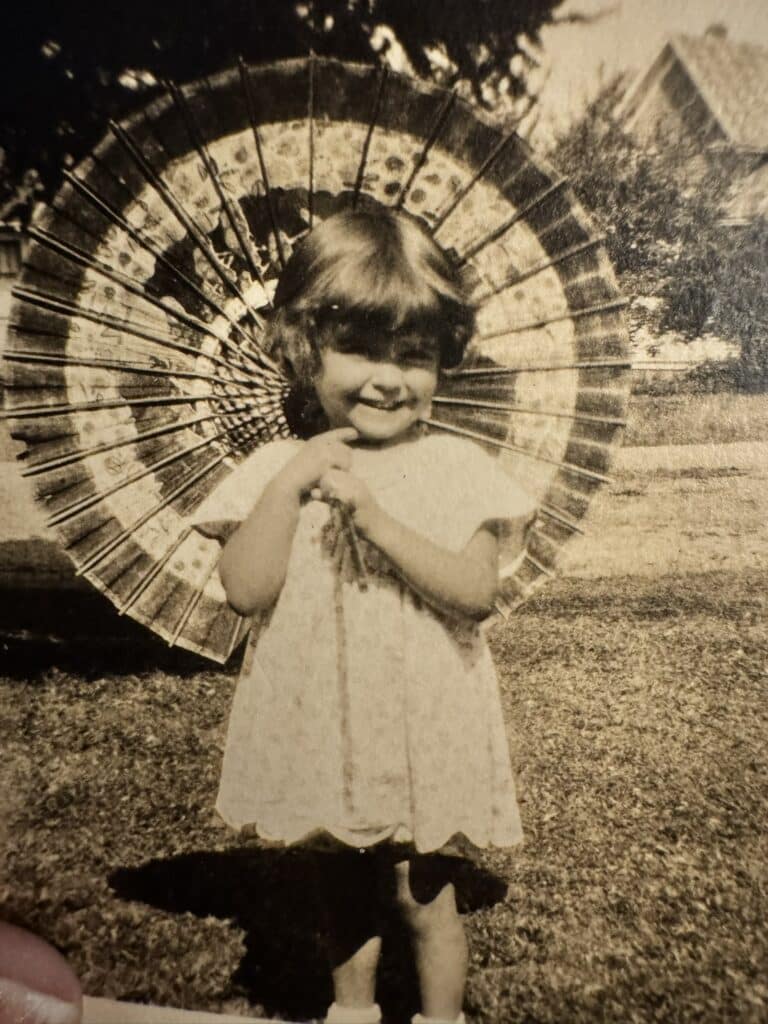
Jean Wolford, late 1920s in Tacoma.
In my last story, I promised readers the tale of Jean Wolford — the little girl in a photograph Greg and I found at a secondhand store. We wondered who the girl was, standing there, frozen in time with her curious half-smile, pretty parasol and, as we soon discovered, a last name that almost wasn’t hers. In fact, as it relates to this family, the first appearance of Wolford, the English surname half of Jean’s entire immediate family uses, traces back to a pivotal moment in the 1800s several states away when fate dramatically reshaped the life of Jean’s paternal grandfather, John Hauswirth.
But to understand how Jean came to be a Wolford at all, I have to start with a different story — one that begins aboard an immigrant ship and ends with a man collapsing in the street, a family shattered, and a new one formed out of kindness and loss.
That story, the Hauswirth’s story, had to be told first.
It began in Germany
Brigida Stelzer was born Nov. 1, 1836, in southern Germany. She married Georg Heinrich Hauswirth in 1863, at age 27, and the couple began their family in the town of Weingarten. Five years into their union, Georg and Brigida took a bold leap — packing up their young children and setting sail for the United States, chasing the promise of a new life across the Atlantic.
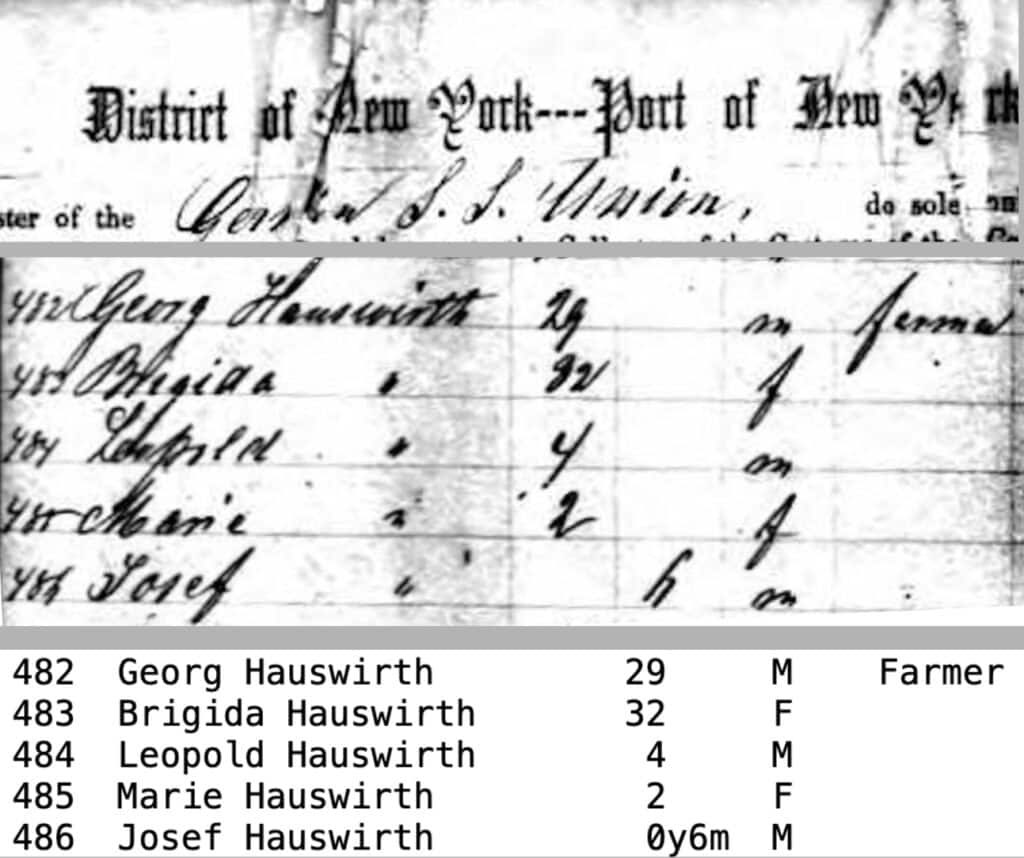
Passenger List for the S.S. Union, a German immigrant steamship that brought the Hauswirths to the United States on Sept. 25, 1868.
Boarding the German steamship the S.S. Union, the family of five departed from Bremen, Germany, made a stop in Southampton, England and then set sail for America. They entered the U.S. via New York’s Castle Garden, the immigration depot that predates the famed Ellis Island. The Hauswirth family arrived on Sept. 25, 1868. Their children — Leopold “Frank” (4 years old), Marie “Mary” (2 years old), and Josef (6 months old)—traveled with them. All five were marked as staying in the steerage portion of the ship, a third-class ticket with accommodations near bottom of the ship, likely making their voyage noisy and crowded.
Headed for Chicago
On the S.S. Union’s manifest, the Hauswirths listed Wisconsin as their intended destination — but it’s not clear if they ever got there. The family resurfaced two years later in Chicago, in the U.S. Census taken on July 23, 1870. Georg, the dad, is listed as a laborer, and Brigida was a laborer of another kind. Her role was noted as ‘keeping house,’ and she had steadily welcomed a new baby every two years or less since she and Georg married back in Germany. By this point, baby Josef, who had immigrated with them, had passed away. I haven’t found his death certificate yet, though one may exist. But Leopold and Marie “Mary” were still living with their parents. And, 1870 also marked the birth of a new child: Georg Adam Hauswirth, 4 months old, born in Illinois.

1870 U.S. Census | Hauswirth Family
In a few years, Chicago would also be the birthplace of their middle son, Johann “John” Georg Hauswirth, born in October 1873. He’s a key player in this story, so we’ll circle back to him later.
Houseworth
After 1870 or so, the Hauswirths were being referred to by the Anglicized spelling of their German name: “Houseworth.” Two or three children later, the Houseworths were no longer in Chicago, but were instead had settled in Tecumseh, Nebraska in Johnson County, located in the southeastern corner of the state. George sported an ‘e’ at the end of his name by then, and Census takers noted he was a farmer. For her part, Brigida, became known as the Anglicized “Bridget” and she was still keeping house and being a mama to a growing brood. In fact, she and George went on to have at least 12 children, maybe more, including two sets of twins. Sadly, many of their children died as infants or in early childhood.

The Falls City Journal, July 20, 1878; Clip found by Greg Spadoni.
Delirium tremens
In 1878, tragedy struck the family again — this time at its head. Under bizarre circumstances, newspapers reported that George had — quite literally — dropped dead from “delirium tremens,” a severe condition associated with hallucinations from alcohol withdrawal. His death was sudden, according to the accounts, and involved running from imaginary things, collapsing from heat exhaustion and dying in the street. Shoutout to Greg for finding this news clip, as it gives rare details about a person for this period of history.
The reporter ends the article with an unsolicited “moral of the story” that likely wouldn’t pass today’s copy desk, but—given the circumstances—the idea still holds weight. He wrote: “An occurrence of this kind in a community is a stronger temperance lecture than all the eloquent speeches of Murphy and Finch combined.”
That insight—suggesting a warning to others that the effects of alcohol could be alarmingly destructive —references two prominent temperance/ anti-alcohol speakers of the era: Francis Murphy, a reformed alcoholic known for his charismatic crusades promoting sobriety; and John B. Finch, who initially eluded my research. Then Greg found references to Finch saying that in the 1800s, Finch delivered town hall–style public lectures against booze and handed out red ribbons to supporters who pledged to discourage alcohol consumption in their communities.
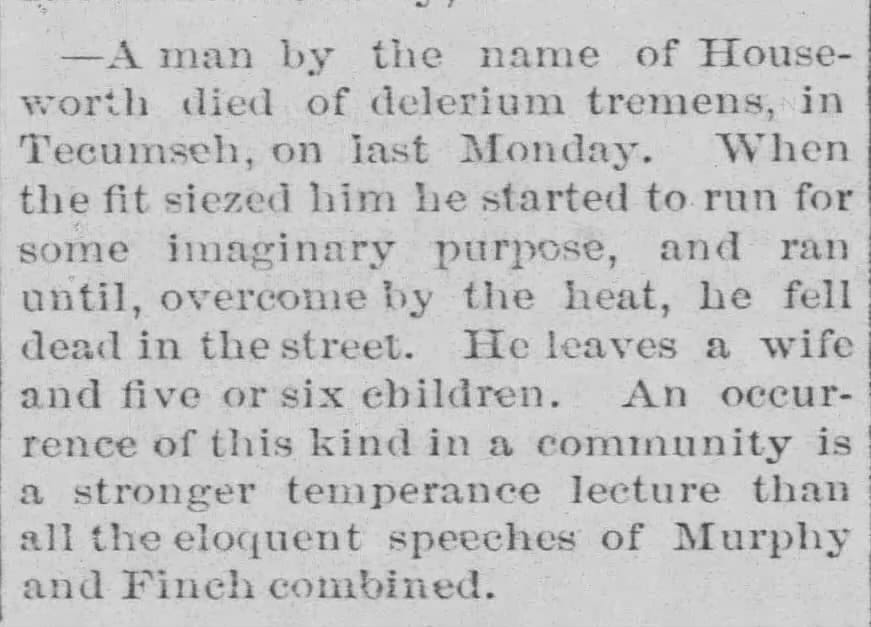
The Falls City Journal, July 20, 1878
Bridget, home with their children and suddenly widowed, faced an uncertain future. Then, several months after George died, in an occurrence perhaps no one saw coming, Bridget, tragically, died too. I was unable to find a death certificate for her since her name is spelled about 18 different ways on her genealogical records, which tends complicates things, but I’ll keep looking. In the meantime, when comparing her death year with those of her children, it appears Bridget may have died at the same time, or close to the same time, as the birth of her second set of twins. Those twins, whose names were not immediately available, have 1879 as the year of their birth and death — and that’s same year Bridget died. She was 43 years old.
New homes
The couple’s children were orphaned, and subsequently split up among different households. And which family do you think took in John, the guy I promised to steer us back to? Why, yes, he was indeed welcomed into the home of Solomon and Ellen Wolford, a well-respected couple who lived in or just outside of the same town as the Houseworths.
Solomon, a Civil War veteran and former teacher, homesteaded in Nebraska and served as county superintendent and commissioner. Ellen, who married Solomon after her first husband died, was a mom and teacher. The Wolfords had no children together, so they adopted John and two of his sisters. The older of the two sisters was Maggie Houseworth, and the other was the baby Mattie Houseworth, who was still under a year old. (If that timeline is accurate – one might imagine how the body of a 40-something female handles giving birth to a baby only to get immediately pregnant with twins afterward). It’s unclear from the records why, but Mattie died with the Wolfords when she was about 13 months old. The couple also took in what I think is an entirely different family’s baby, named Mabel Lorena, who was left on their doorstep as an infant. Little Mabel lived only about six more months after that.
Solomon and Ellen gave John and Maggie not only their home and their own land later in life, but also their last name — Wolford. And, in what might be a testament to his admiration of them, John kept that last name and passed it on to his wife and their own children. Maggie also kept it, but as these things tend to go, she eventually married to become Maggie Reed.
And now we’ve almost come to the point in this story where we circle back to John Wolford, Jean Wolford’s grandfather.
John Hauswirth Wolford
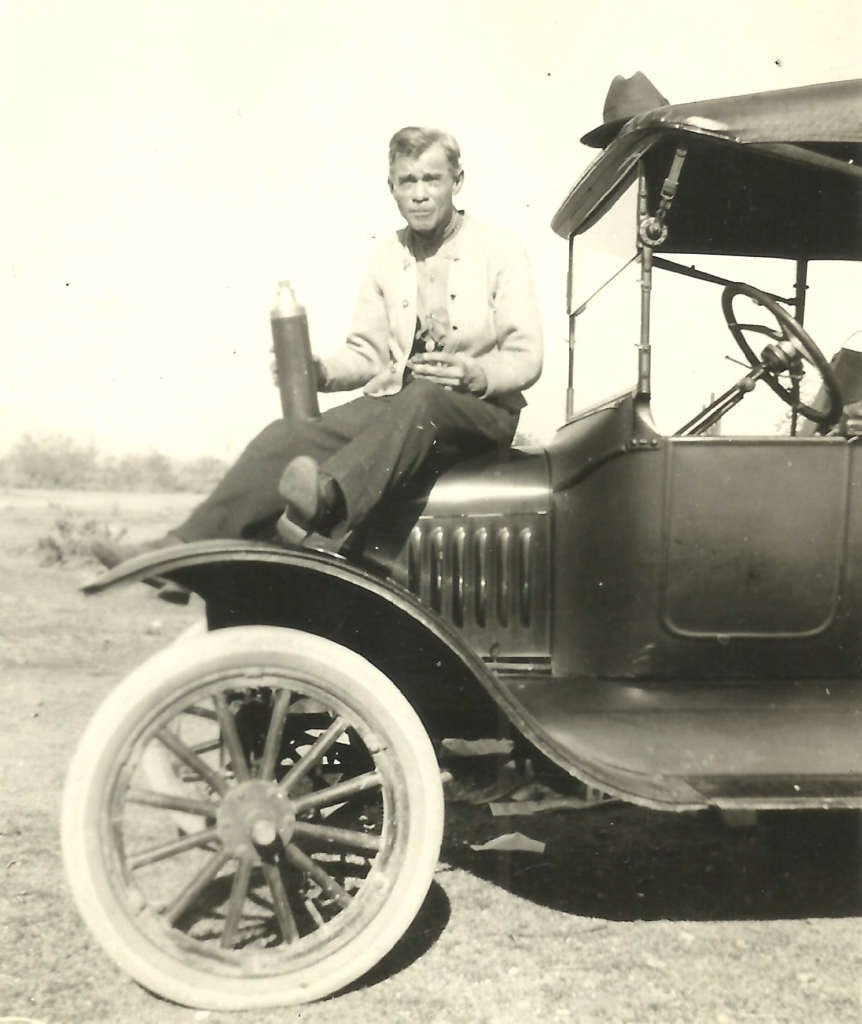
John Hauswirth Wolford
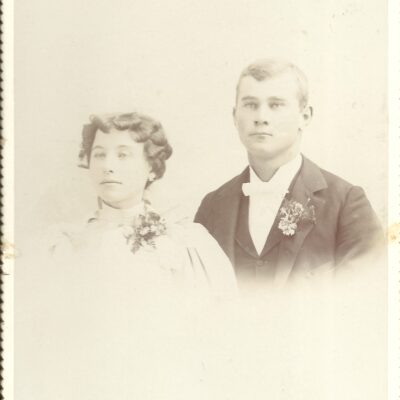
Leta (Hopwood) and John Wolford. They married in 1895. Perhaps this undated photograph is their wedding picture.
John Hauswirth Wolford was born in October 1873 in Chicago as a Hauswirth (and a Houseworth), but he carried the Wolford name for the rest of his life after age 5.
In 1893, when John Wolford was 20 years old, he moved to Selden, Kansas. Three years later, in 1895, he married the lovely Leta Hopwood — and we have what appears to be their wedding picture in our secondhand store collection. John’s sister Maggie remained in contact with John through the years. After John’s death in 1937, Maggie received word of his passing and told the newspapers.
John and Leta Wolford of Tacoma
But, three decades before that, back in 1907, John and his new wife Leta Wolford moved to Tacoma, where John worked as a blacksmith with the Northern Pacific Railroad shops in South Tacoma. The trains were repaired, overhauled, and painted in the complex of shop buildings, which Greg says was a major employer at the time
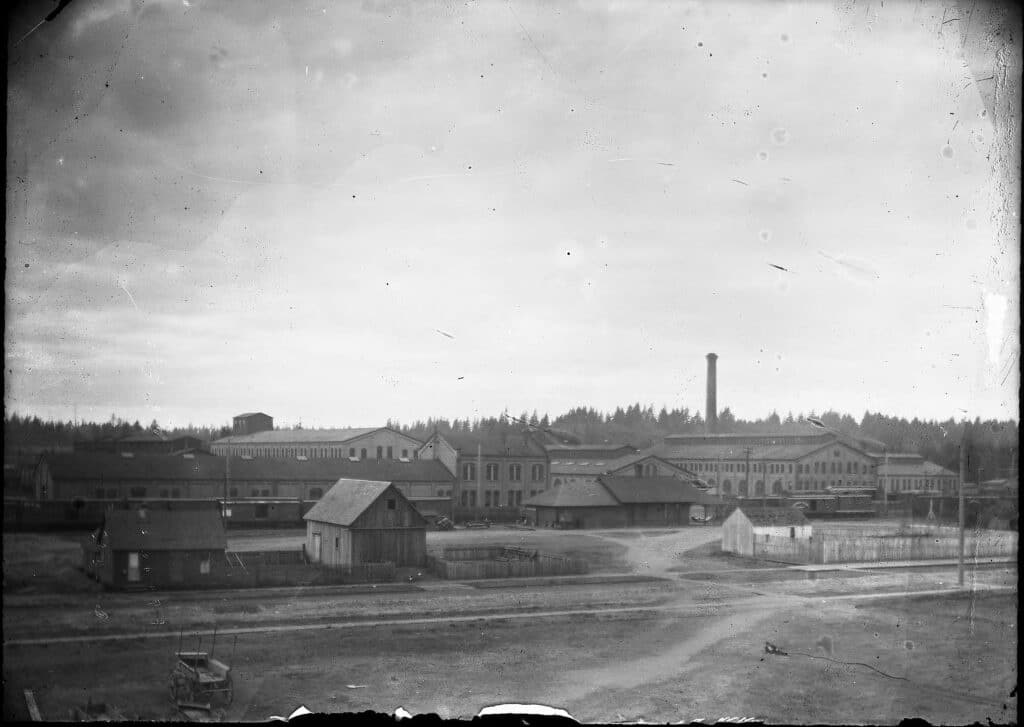
The Northern Pacific Railroad shops in South Tacoma where John Hauswirth worked starting in 1907. Picture dated circa 1908. Source: Northwest Room at The Tacoma Public Library, Amzie D. Browning Collection BROWNING-080.
Blacksmiths were needed for metal casting so the Northern Pacific Railroad could make parts instead if buying them. couple had four children: Don, Clyde (who died in infancy), Guida, and Marion (often spelled in her records as Marian). Their eldest son, Don Solomon Wolford (keen eyes will see he bore the full name of John’s adopted dad) married Doris Persing of Tacoma. The pair remained on the Puget Sound, living in Tacoma and Cromwell. They had one child, a daughter: Jean Guida Wolford.
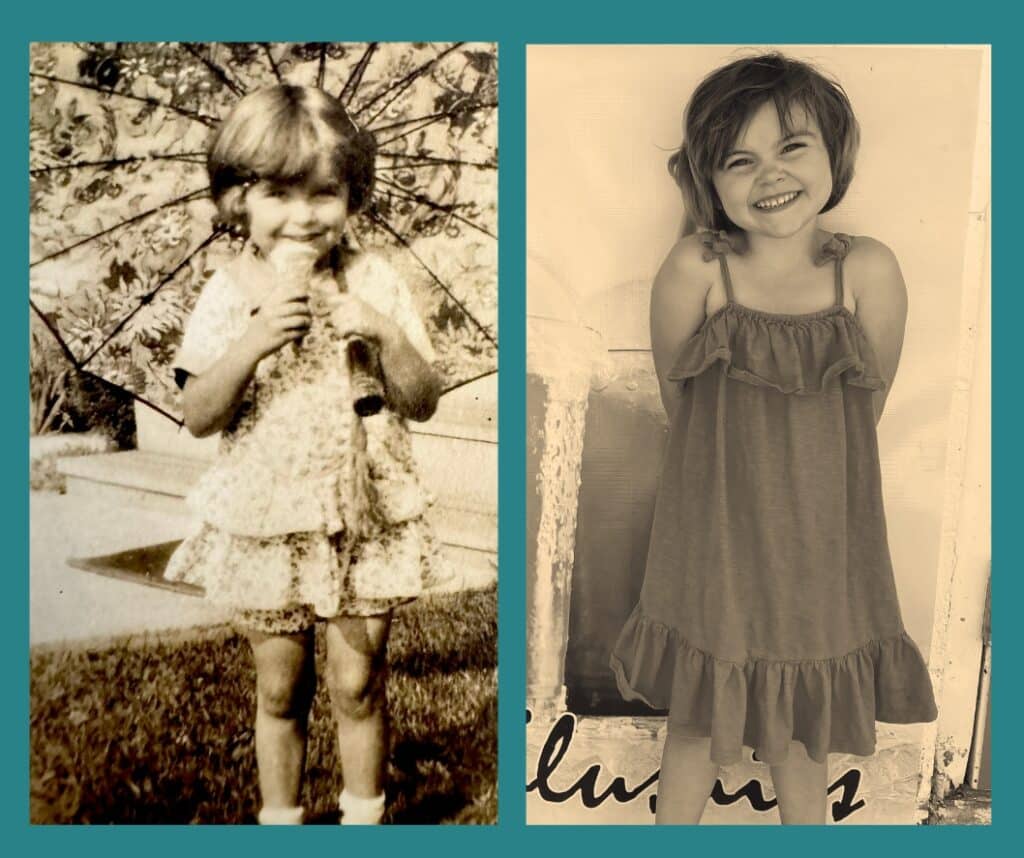
From left: Jean Wolford, circa 1930; Delphi, Tonya’s niece, circa 2024.
And that pretty lady is my niece’s little doppelganger — the subject of next week’s installment of Behind the Finds.
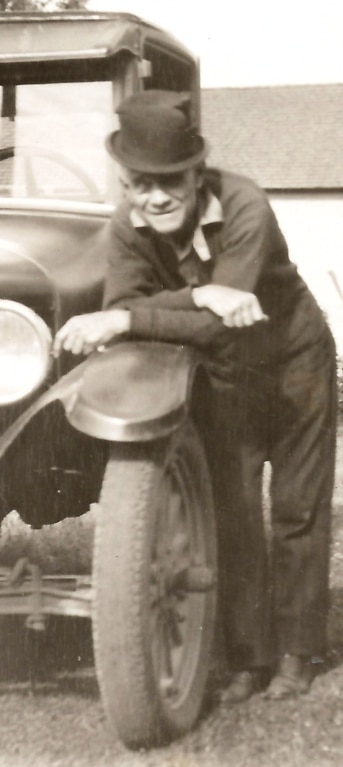
We have quite a few pictures of John Hauswirth Wolford, often hanging with the kids, leaning on an old car and spending time with family. News clips tell us that he even spent time with Solomon Wolford in his later years when Solomon came to visit his son John in Tacoma, all the way from Nebraska.
Check back next week to learn the rest of little Jean Wolford’s story.

